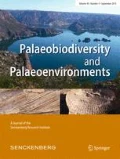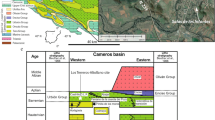Abstract
A diversified fauna of fossil mammals is described from the Thanetian Marnes de Montchenot near Reims (France, Paris Basin). The new fauna is composed mainly of micromammals, which are represented by isolated teeth and a few more complete dental remains. Multituberculates, insectivore-like mammals and louisinine “condylarths” are particularly common at Montchenot, and tiny toliapinid plesiadapiforms are relatively well represented. In contrast, the larger-sized plesiadapiform Plesiadapis and pleuraspidotheriid “condylarths” are less abundant than at Cernay or Berru. Special attention is paid to Neoplagiaulax nicolai, the most common species of multituberculate at Montchenot. The new sample of this species allows to reconsider the composition of its upper premolar series and the orientation of isolated deciduous anterior upper premolars in neoplagiaulacids. Insectivore-like mammals from Montchenot include a previously unrecognised adapisoriculid, known by the complete upper and lower molar series, which combines an Afrodon-like morphology with strong posterior cingula on its upper molars. Mammal fossils indicate an age of the Montchenot fauna close to Cernay (European mammalian reference level MP6), confirming previous age determinations based on mollusks and charophytes. Preservational biases including selective predation and hydrodynamic sorting, possibly in combination with specific palaeoenvironmental conditions related to deposition in a quiet freshwater milieu, seem to be responsible for the peculiar composition of the mammalian fauna from Montchenot compared to other late Paleocene localities in the Paris Basin.







Similar content being viewed by others
Notes
Also known as Mont-Chenot (Laurain et al. 1981)
Following Zack et al. (2005), the Louisininae are here considered as members of the Apheliscidae. This family name has been revived for forms previously placed in the Hyopsodontidae excluding the type genus Hyopsodus Leidy, 1870. The latter seems in fact more closely related to forms traditionally considered as Mioclaenidae, which are now placed in the redefined Hyopsodontidae (ibid.). Hooker and Russell (2012) have raised the Louisininae to family rank and consider them, together with the Apheliscidae, as basal Macroscelidea. Evaluating these systematic changes is beyond the scope of this paper, and Louisininae are here retained as a subfamily within the “condylarth” family Apheliscidae.
Andrews (1990) found the proportion of mammalian molars showing signs of digestion in pellets of different birds of prey and scat of different mammalian predators to vary strongly with the predator species (between 0 % and close to 100 % for avian predators). In almost all cases, a significant part of ingested molars had no visible signs of digestion. Absence of evidence for digestion in individual fossil teeth can thus not be interpreted as evidence against these teeth having been ingested by a predator.
Based on the faunal list of Russell et al. (1966), mammals known from the Marnes de Rilly include Neoplagiaulax eocaenus, N. copei, N. nicolai [=Neoplagiaulax sp. A (ibid.)], Liotomus marshi, Walbeckodon girardi [=Adunator lehmani? (ibid.)], Adapisorex gaudryi, Plesiadapis tricuspidens, Dipavali petri and Orthaspidotherium edwardsi.
References
Andrews P (1990) Owls, caves and fossils. Natural History Museum, London
Bast E de, Sigé B, Smith T (2012) Diversity of the adapisoriculid mammals from the early Paleocene of Hainin, Belgium. Acta Paleontol Pol 57:35–52
Boyer DM, Prasad GVR, Krause DW, Godinot M, Goswami A, Verma O, Flynn JJ (2010) New postcrania of Deccanolestes from the Late Cretaceous of India and their bearing on the evolutionary and biogeographic history of euarchontan mammals. Naturwissenschaften 97:365–377
Fisher DC (1981) Taphonomic interpretation of enamel-less teeth in the Shotgun local fauna (Paleocene, Wyoming). Contrib Mus Paleontol Univ Mich 25:259–275
Freytet P, Duringer P, Koeniguer J, Lablanche G, Laurain M, Pons D (2001) Distribution and paleoecology of freshwater algae and stromatolithes: IV, some examples from the Tertiary of the Paris Basin and the Alsace Graben (France). Ann Paleontol 87:143–205
Hooker JJ (1998) Mammalian faunal change across the Paleocene-Eocene transition in Europe. In: Aubry M, Lucas SG, Berggren WA (eds) Late Paleocene-early Eocene climatic and biotic events in the marine and terrestrial records. Columbia University Press, New York, pp 428–450
Hooker JJ, Millbank C (2001) A Cernaysian mammal from the Upnor Formation (Late Paleocene, Herne Bay, UK) and its implications for correlation. Proc Geolog Assoc 112:331–338
Hooker JJ, Russell DE (2012) Early Palaeogene Louisinidae (Macroscelidea, Mammalia), their relationships and north European diversity. Zool J Linn Soc 164:856–936
Krause DW (1977) Paleocene multituberculates (Mammalia) of the Roche Percée local fauna, Ravenscrag Formation, Saskatchewan, Canada. Palaeontograph Abt A 159:1–36
Ladevèze S, Missiaen P, Smith T (2010) First skull of Orthaspidotherium edwardsi (Mammalia, “Condylarthra”) from the Late Paleocene of Berru (France) and phylogenetic affinities of the enigmatic European family Pleuraspidotheriidae. J Vertebr Paleontol 30:1559–1578
Laurain M, Meyer R (1986) Stratigraphie et paléogéographie de la base du Paléogène champenois. Geolog Fr 1986:103–123
Laurain M, Henry P (1968) Montchenot: Gisement accessible de la faune thanétienne du calcaire lacustre de Rilly. Ann Univ ARERS Reims 6:127–132
Laurain M, Guérin H, Barta L, Montciardini C, Neiss R (1981) Carte géologique à 1/50 000, feuille de Reims, no. 132. Bureau de Recherches Géologiques et Minières, Orléans
Lillegraven JA (1969) Latest Cretaceous mammals of upper part of Edmonton Formation of Alberta, Canada, and review of marsupial-placental dichotomy in mammalian evolution. University of Kansas paleontological contributions 50
López-Martínez N, Smith R, Peláez-Campomanes P, Smith T (2006) The acme of the micromammal Paschatherium across the Paleocene-Eocene boundary in continental Europe. Micropaleontology 52:267–280
López-Martínez N, Peláez-Campomanes P (1999) New mammals from south-central Pyrenees (Tremp Formation, Spain) and their bearing on late Paleocene marine-continental correlations. Bull Soc Geol Fr 170:681–696
Louis P (1996) Recherches de mammifères paléogènes dans les départements de l’Aisne et de la Marne pendant la deuxième moitié du vingtième siècle. Palaeovertebrata 25:83–113
Mellett JS (1974) Scatological origins of microvertebrate fossil accumulations. Science 185:349–350
Riveline J (1976) Étude floristique des niveaux marneux de la carrière de Montchenot (Marne). Mise en évidence d’une nouvelle association de Characées d’âge thanétien. C R Acad Sci Paris ser D 283:25–28
Russell DE (1964) Les mammifères paléocènes d’Europe. Mém Mus Natl Hist Nat ser C 13:1–324
Russell DE, Louis P, Poirier M (1966) Gisements nouveaux de la faune cernaysienne (Mammifères paléocènes de France). Bull Soc Geol Fr 7e ser 7:845–856
Scott CS (2005) New neoplagiaulacid multituberculates (Mammalia: Allotheria) from the Paleocene of Alberta, Canada. J Paleontol 79:1189–1213
Smith T, de Bast E, Sigé B (2010) Euarchontan affinity of Paleocene Afro-European adapisoriculid mammals and their origin in the Late Cretaceous Deccan Traps of India. Naturwissenschaften 97:417–422
Storch GD (2008) Skeletal remains of a diminutive primate from the Paleocene of Germany. Naturwissenschaften 95:927–930
Szalay FS (1965) First evidence of tooth replacement in the subclass Allotheria (Mammalia). Am Mus Novit 2226:1–12
Szalay FS (1968) Origins of the Apatemyidae (Mammalia, Insectivora). Am Mus Novit 2352:1–11
Vianey-Liaud M (1986) Les multituberculés thanétiens de France, et leurs rapports avec les multituberculés nord-américains. Palaeontograph Abt A 191:85–171
Zack SP, Penkrot TA, Krause DW, Maas MC (2005) A new apheliscine “condylarth” mammal from the late Paleocene of Montana and Alberta and phylogeny of “hyopsodontids”. Acta Paleontol Pol 50:809–830
Acknowledgements
The authors thank M. Laurain for helpful discussions of local geology, M. Duchamplecheval, E. Herbomel (EPHE) and several residents of Villers-Allerand for support during excavations at Montchenot. The Marguet Champagne (B. Marguet) provided a washing and screening site in Ambonnay. E. Zoukouba (EPHE) and the staff of the Musée national d’Histoire naturelle de Luxembourg helped in sorting residue. J.-C. Rage kindly provided first determinations for the herpetofauna of Montchenot. M. Vianey-Liaud and E. Gheerbrant provided helpful comments for improving this paper.
Author information
Authors and Affiliations
Corresponding author
Additional information
This article is a contribution to the special issue “Messel and the terrestrial Eocene—Proceedings of the 22nd Senckenberg Conference”
Rights and permissions
About this article
Cite this article
Jehle, M., Godinot, M., Delsate, D. et al. A new late Paleocene micromammal fauna from Montchenot (Paris Basin). Preliminary results. Palaeobio Palaeoenv 92, 487–496 (2012). https://doi.org/10.1007/s12549-012-0100-x
Received:
Revised:
Accepted:
Published:
Issue Date:
DOI: https://doi.org/10.1007/s12549-012-0100-x




